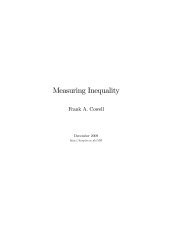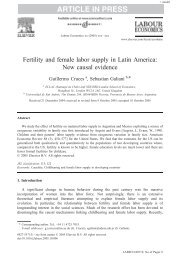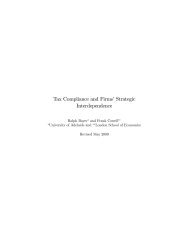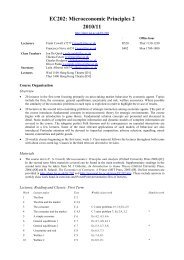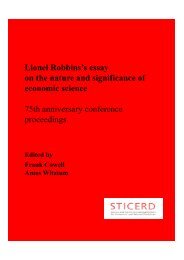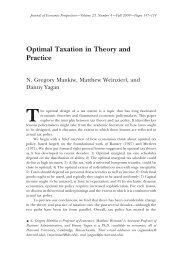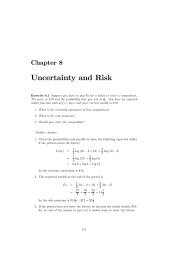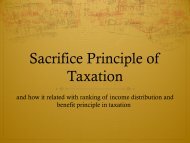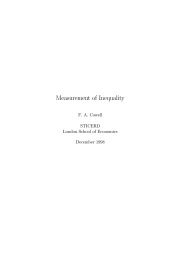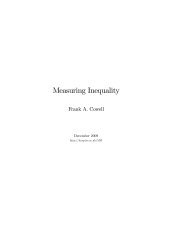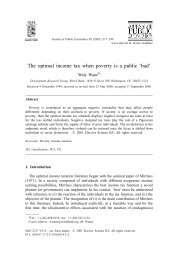Wealth Distribution and Taxation - DARP
Wealth Distribution and Taxation - DARP
Wealth Distribution and Taxation - DARP
You also want an ePaper? Increase the reach of your titles
YUMPU automatically turns print PDFs into web optimized ePapers that Google loves.
<strong>Wealth</strong> <strong>Distribution</strong> <strong>and</strong><br />
<strong>Taxation</strong><br />
EC426<br />
http://darp.lse.ac.uk/ec426<br />
11 February 2013
Overview...<br />
<strong>Wealth</strong> <strong>Distribution</strong><br />
<strong>and</strong> <strong>Taxation</strong><br />
<strong>Wealth</strong> taxation<br />
Why wealth taxation?<br />
Types of tax<br />
<strong>Wealth</strong><br />
distribution<br />
<strong>Wealth</strong> trends<br />
Long-run<br />
models<br />
11 February 2012 Frank Cowell: EC426<br />
2
<strong>Wealth</strong> taxation <strong>and</strong> its alternatives<br />
• Annual wealth tax:<br />
• mostly on an overall measure of net worth<br />
• some specific wealth taxes (property taxes)<br />
• Inheritance / estate tax:<br />
• taxes on transfer of wealth at death<br />
• inheritance tax: on the beneficiaries of the estate<br />
• estate tax: on personal representatives of the deceased<br />
• Transfer tax<br />
• taxes transfer of wealth not necessarily at death<br />
• On other side of balance sheet?<br />
• “asset-based egalitarianism”<br />
• start-of-life grants<br />
• state pension provision<br />
11 February 2012 Frank Cowell: EC426 3
Proportion of tax revenue raised by…<br />
All property<br />
taxes<br />
<strong>Wealth</strong> <strong>and</strong> W<br />
transfer taxes<br />
<strong>Wealth</strong><br />
transfer taxes<br />
11 February 2012 Frank Cowell: EC426 4
Why wealth taxation?<br />
• Revenue raising is unlikely to be major role<br />
• revenue raised less than 1% of receipts?<br />
• see OECD Revenue Statistics<br />
• Efficiency case for or against wealth taxation is unclear<br />
• (Cremer <strong>and</strong> Pestieau 2003)<br />
• Equity case for wealth taxation is more promising<br />
• direct impact of wealth taxation on redistribution must be small<br />
• in long run taxes may influence savings <strong>and</strong> bequest behaviour<br />
• these influence wealth accumulation <strong>and</strong> inequality<br />
11 February 2012 Frank Cowell: EC426 5
Overview...<br />
<strong>Wealth</strong> <strong>Distribution</strong><br />
<strong>and</strong> <strong>Taxation</strong><br />
<strong>Wealth</strong> taxation<br />
Definitions,<br />
composition <strong>and</strong><br />
inequality<br />
<strong>Wealth</strong><br />
distribution<br />
<strong>Wealth</strong> trends<br />
Long-run<br />
models<br />
11 February 2012 Frank Cowell: EC426<br />
6
<strong>Wealth</strong> concepts: UK example<br />
• British Household Panel Survey<br />
• fairly comprehensive<br />
• suffers from st<strong>and</strong>ard participation / attrition problems<br />
• <strong>Wealth</strong> <strong>and</strong> assets survey<br />
• uses survey <strong>and</strong> administrative data – comprehensive<br />
• newly emerged, so no time-series analysis<br />
• HMRC Identified personal wealth<br />
• emerges directly from the estate multiplier method<br />
• it is clearly biased (missing wealth, missing persons)<br />
• differs from balance-sheet concept of wealth<br />
• HMRC Series C: marketable wealth only<br />
• valuation issues addressed<br />
• excluded population corrected<br />
• HMRC Series D: includes a valuation of pension rights<br />
• HMRC Series E: includes a valuation of state pension rights<br />
11 February 2012 Frank Cowell: EC426 7
net capital value of<br />
estate<br />
Securities<br />
Cash<br />
Loans, mortgages<br />
etc<br />
Policies of<br />
insurance<br />
Residential<br />
buildings<br />
Other Buildings<br />
<strong>and</strong> L<strong>and</strong><br />
Other assets<br />
Net as % gross<br />
Mortgages<br />
Other debts<br />
HMRC “Identified wealth” 2003<br />
0 - £50,000 4.6% 22.7% 5.6% 8.9% 47.6% 0.1% 10.5% 61.0% 5.7% 33.4%<br />
£50000 - £100,000 4.5% 16.2% 3.0% 14.6% 55.0% 0.0% 6.8% 83.3% 4.1% 12.6%<br />
£100000 - £150,000 3.9% 14.0% 2.4% 18.6% 55.2% 0.1% 5.8% 84.4% 4.3% 11.3%<br />
£150000 - £200,000 4.5% 14.4% 0.7% 12.1% 59.4% 1.6% 7.5% 89.0% 4.9% 6.1%<br />
£200000 - £500,000 8.5% 12.8% 0.9% 12.6% 54.7% 1.5% 9.0% 89.7% 6.5% 3.8%<br />
£500000 - £1000,000 17.6% 11.2% 1.6% 7.6% 42.5% 5.3% 14.1% 93.8% 3.9% 2.3%<br />
£1,000,000 <strong>and</strong> over 23.8% 10.8% 1.9% 5.0% 28.1% 8.1% 22.4% 94.2% 2.9% 3.0%<br />
Residential buildings about 50% of net worth, except for £500,000+<br />
Debts concentrated amongst those with less than £100,000<br />
Source: HMRC statistics table 13.2<br />
Securities concentrated amongst the rich<br />
11 February 2012 Frank Cowell: EC426 8
Proportion of wealth in residential buildings.<br />
UK 1999<br />
60%<br />
50%<br />
40%<br />
age 18-44<br />
age 45-64<br />
aged 65 <strong>and</strong> over<br />
All ages<br />
30%<br />
20%<br />
10%<br />
0%<br />
0 - £50,000<br />
£50,000 -<br />
£100,000 -<br />
£150,000 -<br />
£200,000 -<br />
£500,000 -<br />
£1,000,000 -<br />
11 February 2012 Frank Cowell: EC426 9
Proportion of wealth in residential buildings.<br />
UK 2003<br />
70%<br />
60%<br />
age 18-44<br />
age 45-64<br />
aged 65 <strong>and</strong> over<br />
All ages<br />
50%<br />
40%<br />
30%<br />
20%<br />
10%<br />
0%<br />
0 - £50,000 £50,000 - £100,000 - £150,000 - £200,000 - £500,000 - £1,000,000 -<br />
11 February 2012 Frank Cowell: EC426 10
Proportion of wealth in securities. UK 2003<br />
35%<br />
30%<br />
25%<br />
20%<br />
age 18-44<br />
age 45-64<br />
aged 65 <strong>and</strong> over<br />
All ages<br />
15%<br />
10%<br />
5%<br />
0%<br />
0 - £50,000<br />
£50,000 -<br />
£100,000 -<br />
£150,000 -<br />
£200,000 -<br />
£500,000 -<br />
£1,000,000 -<br />
11 February 2012 Frank Cowell: EC426 11
Proportion of wealth<br />
<strong>Wealth</strong> concepts <strong>and</strong> inequality<br />
1.0<br />
Identified <strong>Wealth</strong> Gini=0.58<br />
Series C Gini=0.67<br />
Series D Gini=0.59<br />
Series E Gini=0.49<br />
pretax income Gini=0.25<br />
0.9<br />
0.8<br />
0.7<br />
0.6<br />
0.5<br />
0.4<br />
0.3<br />
0.2<br />
0.1<br />
0.0 0.1 0.2 0.3 0.4 0.5 0.6 0.7 0.8 0.9 1.0<br />
Proportion of population<br />
11 February 2012 Frank Cowell: EC426 12<br />
0.0
Household portfolio composition – LWS<br />
<strong>Wealth</strong> components Canada Finl<strong>and</strong> Germany Italy Sweden<br />
United<br />
Kingdom<br />
US<br />
PSID<br />
US<br />
SCF<br />
1999 1998 2002 2002 2002 2000 2001 2001<br />
Non-financial assets 78 84 87 85 72 83 67 62<br />
Principal residence 64 64 64 68 61 74 52 45<br />
Real estate 13 20 23 17 11 9 14 17<br />
Financial assets 22 16 13 15 28 17 33 38<br />
Deposit accounts 9 10 n.a. 8 11 9 10 10<br />
Bonds 1 0 n.a. 3 2 n.a. n.a. 4<br />
Stocks 7 6 n.a. 1 6 n.a. 23 15<br />
Mutual funds 5 1 n.a. 3 9 n.a. n.a. 9<br />
Total assets 100 100 100 100 100 100 100 100<br />
Total debt 26 16 18 4 35 21 22 21<br />
Home secured 22 11 15 2 n.a. 18 n.a. 18<br />
Total net worth 74 84 82 96 65 79 78 79<br />
Source: Sierminska et al (2006)<br />
11 February 2012 Frank Cowell: EC426 13
LWS: <strong>Wealth</strong> inequality in four countries<br />
Gini Share Share Share<br />
Top 10% Top 5% Top 1%<br />
UK 0.665 0.456 0.301 0.101<br />
Sweden 0.893 0.582 0.406 0.175<br />
Canada 0.747 0.532 0.374 0.151<br />
US 0.836 0.705 0.575 0.329<br />
Source: Cowell (2012)<br />
11 February 2012 Frank Cowell: EC426 14
LWS: Net worth<br />
1.0<br />
Canada 1999 NW1<br />
US SCF 2000 NW1<br />
UK 2000 NW1<br />
Sweden 2002 NW1<br />
0.9<br />
0.8<br />
0.7<br />
0.6<br />
0.5<br />
0.4<br />
0.3<br />
0.2<br />
0.1<br />
0.0<br />
0.0 0.1 0.2 0.3 0.4 0.5 0.6 0.7 0.8 0.9 1.0<br />
-0.1<br />
11 February 2012 Frank Cowell: EC426 15
LWS: breakdown by wealth group<br />
Gini Share Gini<br />
overall rich rich non-rich between<br />
Top 10%<br />
UK 0.665 0.456 0.240 0.608 0.356<br />
Sweden 0.893 0.582 0.316 1.045 0.482<br />
Canada 0.747 0.532 0.314 0.707 0.432<br />
US 0.836 0.705 0.525 0.730 0.605<br />
Top 5%<br />
UK 0.301 0.206 0.618 0.251<br />
Sweden 0.406 0.314 0.941 0.356<br />
Canada 0.374 0.286 0.702 0.324<br />
US 0.575 0.492 0.735 0.525<br />
Top 1%<br />
UK 0.101 0.148 0.644 0.091<br />
Sweden 0.175 0.327 0.891 0.165<br />
Canada 0.151 0.246 0.720 0.141<br />
US 0.329 0.392 0.776 0.319<br />
11 February 2012 Frank Cowell: EC426 16
LWS: Net worth (top 10%)<br />
1.0<br />
Canada 1999 NW1<br />
0.9<br />
US SCF 2000 NW1<br />
UK 2000 NW1<br />
Sweden 2002 NW1<br />
0.8<br />
0.7<br />
0.6<br />
0.5<br />
0.4<br />
0.3<br />
0.2<br />
0.1<br />
0.0<br />
0.0 0.1 0.2 0.3 0.4 0.5 0.6 0.7 0.8 0.9 1.0<br />
-0.1<br />
11 February 2012 Frank Cowell: EC426 17
LWS: breakdown by asset type<br />
Share of…<br />
Gini Coefficient for…<br />
Top 10% Top 5% Top 1% All Top 10% Top 5% Top 1%<br />
Principal Residence<br />
Principal Residence<br />
UK 0.315 0.190 0.049 UK 0.565 0.280 0.277 0.318<br />
Sweden 0.374 0.234 0.064 Sweden 0.708 0.372 0.353 0.400<br />
Canada 0.303 0.181 0.056 Canada 0.603 0.350 0.381 0.438<br />
US 0.381 0.260 0.097 US 0.645 0.444 0.440 0.465<br />
Investment Property<br />
Investment Property<br />
UK 0.706 0.581 0.295 UK 0.966 0.835 0.770 0.548<br />
Sweden 0.614 0.505 0.328 Sweden 0.949 0.860 0.850 0.839<br />
Canada 0.633 0.466 0.195 Canada 0.930 0.754 0.720 0.660<br />
US 0.809 0.697 0.382 US 0.959 0.812 0.762 0.690<br />
Financial Assets<br />
Financial Assets<br />
UK 0.523 0.351 0.120 UK 0.796 0.546 0.546 0.541<br />
Sweden 0.519 0.382 0.201 Sweden 0.778 0.589 0.593 0.542<br />
Canada 0.675 0.537 0.255 Canada 0.860 0.655 0.605 0.553<br />
US 0.801 0.683 0.442 US 0.899 0.688 0.658 0.555<br />
11 February 2012 Frank Cowell: EC426 18
LWS: Total Assets<br />
11 February 2012 Frank Cowell: EC426 19
LWS: Total Financial Assets<br />
11 February 2012 Frank Cowell: EC426 20
Functional form for wealth distribution<br />
• Distinctive shape of empirical wealth distribution<br />
• Upper tail appears to conform to Pareto model<br />
• Pareto distribution<br />
• F(x) = 1 − [ x / x ] a<br />
• f(x) = ax a x a1<br />
• Simple interpretation<br />
• a captures “weight” of tail<br />
• x “locates” the distribution<br />
• Inequality<br />
average a<br />
= <br />
base a − 1<br />
1<br />
Gini = <br />
2a − 1<br />
f(x)<br />
a = 1.5<br />
a = 2.0<br />
0 1 2 3 4 5<br />
11 February 2012 Frank Cowell: EC426 21
Figure 9. UK Net Worth: Pareto diagram<br />
50%<br />
60%<br />
70%<br />
80%<br />
90%<br />
95%<br />
99%<br />
11 February 2012<br />
Frank Cowell: EC426<br />
22
Pareto estimates<br />
Top 10%: UK Sweden Canada US<br />
OLS 2.55 1.78 1.37 0.48<br />
Robust estimate 1.71 2.10 1.89 1.75<br />
Top 5%: UK Sweden Canada US<br />
OLS 2.90 1.76 1.53 0.52<br />
Robust estimate 2.08 2.18 2.15 2.06<br />
Top 1%: UK Sweden Canada US<br />
OLS 3.52 1.52 1.94 0.73<br />
Robust estimate 3.07 1.61 2.58 2.27<br />
11 February 2012 Frank Cowell: EC426 23
Overview...<br />
<strong>Wealth</strong> <strong>Distribution</strong><br />
<strong>and</strong> <strong>Taxation</strong><br />
<strong>Wealth</strong> taxation<br />
Rising inequality or<br />
stability?<br />
<strong>Wealth</strong><br />
distribution<br />
<strong>Wealth</strong> trends<br />
Long-run<br />
models<br />
11 February 2012 Frank Cowell: EC426<br />
24
Trends in wealth inequality<br />
• Useful to look at trends in distribution<br />
• what effect of wealth taxation in the past?<br />
• equalisation?<br />
• is there a trend toward stability…?<br />
• ….or divergence?<br />
• For historical <strong>and</strong> recent wealth trends in US<br />
• Kopczuk <strong>and</strong> Saez, (2004)<br />
• Substantial time coverage:<br />
• From early 20 th century<br />
• For historical wealth trends in UK<br />
• Atkinson et al. (1989)<br />
• Similar time coverage…<br />
• But incomplete series<br />
• Recent picture from HMRC data<br />
• Recent evidence from Sweden<br />
• Roine <strong>and</strong> Waldenström (2009)<br />
11 February 2012 Frank Cowell: EC426 25
1915<br />
1925<br />
1935<br />
1945<br />
1955<br />
1965<br />
1975<br />
1985<br />
1995<br />
2005<br />
percent<br />
<strong>Distribution</strong> of wealth US 1916-2000<br />
<strong>Wealth</strong> owned by various groups<br />
45<br />
40<br />
35<br />
30<br />
25<br />
20<br />
15<br />
10<br />
5<br />
0<br />
top 2%<br />
top 1%<br />
top 0.5%<br />
top 0.25%<br />
top 0.1%<br />
top 0.05%<br />
top 0.01%<br />
11 February 2012 Frank Cowell: EC426 26
Sweden: top 5 percent<br />
11 February 2012 Frank Cowell: EC426 27
1900<br />
1910<br />
1920<br />
1930<br />
1940<br />
1950<br />
1960<br />
1970<br />
1980<br />
1990<br />
2000<br />
Pareto’s a: USA <strong>and</strong> UK<br />
3<br />
a<br />
2.8<br />
2.6<br />
2.4<br />
2.2<br />
2<br />
US income<br />
UK income<br />
US wealth<br />
Engl<strong>and</strong> & Wales wealth<br />
UK wealth (1)<br />
UK wealth (2)<br />
1.8<br />
1.6<br />
1.4<br />
1.2<br />
• Sources: see Cowell (2011) Chapter 4<br />
11 February 2012 Frank Cowell: EC426 28
<strong>Wealth</strong> trends<br />
• UK Inequality falls in early 20 th century<br />
• roughly from first world war<br />
• substantive rises in income tax <strong>and</strong> estate duty<br />
• Reductions in inequality continue through mid-century<br />
• US inequality falls from time of great depression<br />
• Largely attributable to stock prices<br />
• Large concentration of corporate stock in wealth of very rich<br />
• But US inequality also carried on falling through to 70s<br />
• Antitrust legislation?<br />
• Development of estate tax<br />
• Changing nature of top groups (Edlund <strong>and</strong> Kopczuk 2009 )<br />
• Sweden<br />
• From World War I until late 20 th century equalisation<br />
• From around 1980 trend reversed<br />
11 February 2012 Frank Cowell: EC426 29
Overview...<br />
<strong>Wealth</strong> <strong>Distribution</strong><br />
<strong>and</strong> <strong>Taxation</strong><br />
<strong>Wealth</strong> taxation<br />
Intergenerational<br />
dynamics<br />
<strong>Wealth</strong><br />
distribution<br />
<strong>Wealth</strong> trends<br />
Long-run<br />
models<br />
11 February 2012 Frank Cowell: EC426<br />
30
A way forward<br />
• <strong>Wealth</strong> taxes may work by influencing long-run distribution<br />
• direct impact of wealth taxes on redistribution will be small<br />
• small taxes can have big effect on the equilibrium (Kaplow 2000)<br />
• What kind of model?<br />
• full GE (DeNardi 2004, Cagetti <strong>and</strong> DeNardi 2008 )<br />
• Piecemeal focus<br />
• Story of wealth distribution in the long run (Piketty 2000):<br />
• Specify financial constraints<br />
• Model preferences / tastes / habits<br />
• Model exogenous resource flow<br />
• Specify family formation mechanism<br />
• Preferences: what motivates bequests? (Kopczuk 2010)<br />
• Altruism<br />
• Exchange<br />
• Warm-glow<br />
• Accident <strong>and</strong> inertia<br />
11 February 2012 Frank Cowell: EC426 31
Simplified model (1)<br />
• Focus on the role of consumption<br />
• family features absent<br />
• interaction between intra-/inter-generational factors<br />
• (Champernowne-Cowell 1998, Cowell 2012 )<br />
• A model of single person-dynasties:<br />
• person inherits `q years after attaining adulthood<br />
• dies `q years after inheritance<br />
• leaves all his terminal wealth to one descendant<br />
• Resources<br />
• all get the same earnings, e(q ) at age q<br />
• but people may differ in terms of inherited wealth<br />
• <strong>Taxation</strong>:<br />
• could introduce income or wealth taxes in model<br />
• here focus on wealth-transfer taxation<br />
• simple piecewise linear tax on bequests<br />
• wealth left in excess of W * taxed at rate t<br />
11 February 2012 Frank Cowell: EC426 32
Link between generations<br />
n – 1<br />
0<br />
n<br />
0<br />
B n-1 − tax<br />
B n<br />
n + 1<br />
0<br />
n +2<br />
0<br />
11 February 2012 Frank Cowell: EC426 33
Intra-generational – naïve consumption<br />
• Role of consumption is crucial<br />
• Naïve consumption behaviour:<br />
• income is given by<br />
• consumption aims at a target level:<br />
• earnings are fixed<br />
• <strong>Wealth</strong> accumulation:<br />
• given initial wealth W(0):<br />
• rising/falling wealth:<br />
• W(0) will be determined by intergenerational link<br />
11 February 2012 Frank Cowell: EC426 34
Inter-generational<br />
• Role of taxation is crucial:<br />
• bequest tax:<br />
• Bequest determined by<br />
intragenerational component<br />
• terminal wealth:<br />
• tax determines starting wealth (inheritance)<br />
for next generation<br />
• from tax function:<br />
• Get a model of bequest dynamics:<br />
• connect n <strong>and</strong> n+1:<br />
• use the difference operator<br />
•<br />
11 February 2012 Frank Cowell: EC426 35
Bequest Dynamics<br />
• Overall equation:<br />
• Break this down by tax regime<br />
• For low bequests (below W * )<br />
• dynamics:<br />
• equilibrium:<br />
• For high bequests (above W * )<br />
• dynamics:<br />
• equilibrium:<br />
11 February 2012 Frank Cowell: EC426 36
Bequest Dynamics: naïve consumption<br />
DB n<br />
• The phase diagram<br />
• Paths to riches<br />
• Paths to ruin<br />
• Find equilibria (DB = 0)<br />
• Now cut tax…<br />
0 <br />
B *<br />
oW *<br />
<br />
B **<br />
B n<br />
11 February 2012 Frank Cowell: EC426 37
<strong>Wealth</strong> distribution overall<br />
• <strong>Distribution</strong> of W amongst<br />
f(W)<br />
wealthy<br />
• Take into account lower<br />
equilibrium<br />
w 0<br />
w 1<br />
0<br />
[1-t]B ** +tW<br />
<br />
*<br />
B **<br />
<br />
W<br />
11 February 2012 Frank Cowell: EC426 38
Alternative consumption version<br />
• Consumption proportional to lifetime resources (Becker-Tomes 1979)<br />
• lifetime earnings:<br />
• revised bequest equation:<br />
• Bequest dynamics:<br />
• difference equation:<br />
• equilibrium:<br />
11 February 2012 Frank Cowell: EC426 39
Bequest Dynamics: alternative consumption<br />
DB n<br />
• The phase diagram<br />
• Paths to equilibrium<br />
• Find equilibria (DB = 0)<br />
• Cut tax (high s)<br />
• Cut tax (low s)<br />
0<br />
oW *<br />
<br />
B ***<br />
B n<br />
11 February 2012 Frank Cowell: EC426 40
Simplified model (2)<br />
• Focus on family formation (Champernowne-Cowell 1998)<br />
• each generation is a discrete unit<br />
• pairs always consist of people with equal wealth<br />
• no-one benefits from more than one bequest<br />
• bequest is divided equally amongst the k kids (k given)<br />
• Model applies to upper wealth levels above specified wealth level W *<br />
• For any W>W * , the proportion of testators with k kids is p k :<br />
• independent of W<br />
• p k ≥ 0<br />
• S k p k = 1<br />
• S k kp k = 2<br />
• two examples:<br />
11 February 2012 Frank Cowell: EC426 41
Equilibrium distribution<br />
• Let F n , F n+1 be the wealth distribution in generations n , n+1<br />
• F n (W) is the proportion of the population in generation n with wealth W<br />
• We have equilibrium if F n = F n+1 = F<br />
• Take a person with wealth W in a family where parents had k kids<br />
• if parental wealth was W' per head bequest must have been 2[1−t]W'<br />
• so each kid would get 2[1−t]W'/k<br />
• therefore W' = kW/ 2[1−t]<br />
• given that there are p k such families: F n+1 (W) = S k ½k p k F n (kW/ 2[1−t])<br />
• Equilibrium requires<br />
F(W) = S k ½k p k F(kW/ 2[1−t])<br />
• Only functional form that permits a solution for all W is Paretian<br />
F(W) = 1−AW a<br />
• So the equilibrium condition is:<br />
11 February 2012 Frank Cowell: EC426 42
Tax: Equilibrium <strong>Wealth</strong> <strong>Distribution</strong><br />
• Higher tax produces lower long-run inequality<br />
• If tax is too low – no long-run equilibrium<br />
• Quite low tax rates produce values similar to actual economies.<br />
(i) Narrow<br />
(ii) Wide<br />
t(%) a Gini a Gini<br />
2 1.22 0.410 - -<br />
5 1.55 0.323 1.42 0.352<br />
10 2.11 0.237 1.90 0.263<br />
15 2.73 0.183 2.44 0.205<br />
20 3.43 0.146 3.07 0.163<br />
25 4.28 0.117 3.86 0.130<br />
11 February 2012 Frank Cowell: EC426 43
frequency<br />
Equilibrium <strong>Distribution</strong> t = 10%<br />
0.009<br />
0.008<br />
0.007<br />
0.006<br />
0.005<br />
0.004<br />
0.003<br />
0.002<br />
a = 2.113 (Narrow family spread)<br />
a = 1.9002 (Wide family spread)<br />
0.001<br />
<strong>Wealth</strong><br />
0<br />
200 250 300 350 400 450 500 550 600 650 700 750 800<br />
11 February 2012 Frank Cowell: EC426 44
Summary<br />
• Dynastic model produces a bifurcation<br />
• Convergence to equilibrium distribution<br />
• Inequality within <strong>and</strong> between groups<br />
• Source of inequality lies in savings behaviour<br />
• Role of uncertainty captured in savings behaviour<br />
• Family structure affects long-run equilibrium<br />
• spread out families reduce effectiveness of taxation<br />
• Tweaking the models would modify this a little<br />
• Variation in income<br />
• Out-of-class marriage<br />
• (Champernowne-Cowell 1998)<br />
• Potentially major role for taxation<br />
11 February 2012 Frank Cowell: EC426 45
References (1)<br />
• Atkinson, A. B., Gordon, J. P. F. <strong>and</strong> Harrison, A. J. (1989) “Trends in the shares of top wealthholders<br />
in Britain 1923-1981,” Oxford Bulletin of Economics <strong>and</strong> Statistics, 51, 315-332.<br />
• Becker, G. S. <strong>and</strong> Tomes, N. (1979) “An equilibrium theory of the distribution of income <strong>and</strong><br />
intergenerational mobility,” Journal of Political Economy, 87, 1153-1189.<br />
• Cagetti, M. <strong>and</strong> DeNardi, M. (2008) “<strong>Wealth</strong> Inequality: Data <strong>and</strong> Models,” Macroeconomic<br />
Dynamics, 12 S2, 285–313.<br />
• Champernowne, D. G. <strong>and</strong> Cowell, F. A. (1998) Economic Inequality <strong>and</strong> Income <strong>Distribution</strong>,<br />
Cambridge University Press, Cambridge, Chapter 10.<br />
• Cowell, F.A. (2011) Measuring Inequality, Oxford University Press<br />
• *Cowell, F.A. (2012) “Bequests, taxation <strong>and</strong> the distribution of income <strong>and</strong> wealth,” Review of<br />
Public Economics, 200, 75-93<br />
• *Cowell, F.A. (2013) “UK <strong>Wealth</strong> Inequality in International Context,” in J. Hills (ed.) <strong>Wealth</strong><br />
in the UK: <strong>Distribution</strong> <strong>and</strong> Policy, Oxford University Press, Oxford , Chapter 3.<br />
• *Cremer, H. <strong>and</strong> Pestieau, P. (2003) “<strong>Wealth</strong> Transfer <strong>Taxation</strong>: A Survey,” CESifo Working<br />
Paper No. 106<br />
• DeNardi, M. (2004) “<strong>Wealth</strong> Inequality <strong>and</strong> Intergenerational Links,” Review of Economic<br />
Studies, 71, 743–768.<br />
11 February 2012 Frank Cowell: EC426 46
References (2)<br />
• Edlund, L. <strong>and</strong> Kopczuk, W. (2009) “Women, <strong>Wealth</strong> <strong>and</strong> Mobility,” American Economic<br />
Review, 99, 146–178.<br />
• Kaplow, L. (2000) “A framework for assessing estate <strong>and</strong> gift taxation,” NBER Working<br />
Paper 7775<br />
• Kopczuk, W. (2010) “Economics Of Estate <strong>Taxation</strong>: A Brief Review of Theory And<br />
Evidence,” National Bureau Of Economic Research,” Working Paper 15741<br />
• Kopczuk, W. <strong>and</strong> Saez, E. (2004) “Top <strong>Wealth</strong> Shares in the United States, 1916-2000:<br />
Evidence from Estate Tax Returns,” National Tax Journal, 57, 445-487<br />
• OECD (2008) Growing Unequal? Income <strong>Distribution</strong> And Poverty In OECD Countries,<br />
Organisation For Economic Co-Operation And Development, Paris<br />
• Piketty, T. (2000) “Theories of persistent inequalities,” in Atkinson, A. B. <strong>and</strong><br />
Bourguignon, F. (eds) H<strong>and</strong>book of Income <strong>Distribution</strong>, North Holl<strong>and</strong>, Amsterdam, pp<br />
429-476<br />
• Roine, J. <strong>and</strong> Waldenström, D. (2009) “<strong>Wealth</strong> Concentration over the Path of<br />
Development: Sweden, 1873–2006,” Sc<strong>and</strong>inavian Journal of Economics, 111, 151–187.<br />
• Sierminska, E., Br<strong>and</strong>olini, A. <strong>and</strong> Smeeding, T. M. (2006) “Comparing <strong>Wealth</strong><br />
<strong>Distribution</strong> Across Rich Countries: First Results from the Luxembourg <strong>Wealth</strong> Study,<br />
Luxembourg <strong>Wealth</strong> Study Working Paper 1<br />
11 February 2012 Frank Cowell: EC426 47



